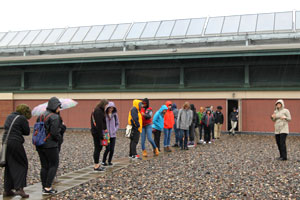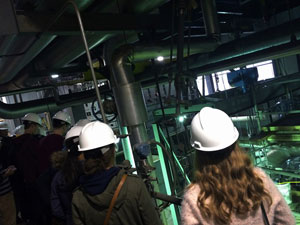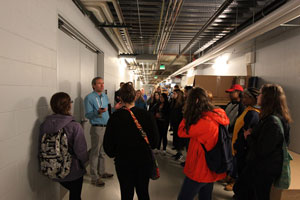On April 9th, 85 environmental studies students from Saint Paul’s Central High School headed to downtown Saint Paul for a special day-long tour. The tour took the students through the new Saint Paul EcoDistrict: the Science Museum of Minnesota, the RiverCentre parking ramp, inside and on top of the RiverCentre and the Saint Paul District Energy plant.
 The Central High School Clean Energy Field trip came about after Lisa Houdek, a science teacher at Central High School, approached the Metro region of the Clean Energy Resource Teams (Metro CERT), a program of the Great Plains Institute, for help in setting up a field trip for her Environmental Studies classes. Houdek teaches about clean energy technologies and sustainability, and wanted her students to be able to see projects being deployed in their own community. Through the Clean Energy Accelerator, Patrick Mathwig from Metro CERT worked with Houdek to establish her goals and get started. Mathwig convened representatives from the Minnesota Science Museum, District Energy, the Saint Paul RiverCentre and the City of Saint Paul. Together, the group developed the tour that would show the students a variety of clean energy technologies already being deployed just a few miles away in downtown Saint Paul.
The Central High School Clean Energy Field trip came about after Lisa Houdek, a science teacher at Central High School, approached the Metro region of the Clean Energy Resource Teams (Metro CERT), a program of the Great Plains Institute, for help in setting up a field trip for her Environmental Studies classes. Houdek teaches about clean energy technologies and sustainability, and wanted her students to be able to see projects being deployed in their own community. Through the Clean Energy Accelerator, Patrick Mathwig from Metro CERT worked with Houdek to establish her goals and get started. Mathwig convened representatives from the Minnesota Science Museum, District Energy, the Saint Paul RiverCentre and the City of Saint Paul. Together, the group developed the tour that would show the students a variety of clean energy technologies already being deployed just a few miles away in downtown Saint Paul.
 To kick the day off, the students heard from Saint Paul’s mayor, Chris Coleman, who spoke to the city’s achievements and the importance of cities taking a leading role in clean energy implementation. Then the tour got underway and started where anyone interested in clean energy should start – energy efficiency. Two stops highlighted the importance of this fact, the Science Museum and the RiverCentre parking ramp. In the Science Museum, staff had installed an advanced heat recovery system that captures the building’s waste heat and, instead of venting it out of the building, uses it to heat the building during cold weather, covering up to 100% of heating needs even down to single digits Fahrenheit. To become more energy efficient as well as safer and more attractive, the RiverCentre parking ramp replaced high pressure sodium lights with florescent lighting, reducing energy usage by 47%. At both of these stops the students also learned about solar photovoltaics (PV). The Science Museum has a 10 kilowatt solar array and the parking ramp has an 83 kilowatt solar array. These arrays supplement the buildings’ electric use and in the case of the parking ramp, powers a row of electric vehicle chargers.
To kick the day off, the students heard from Saint Paul’s mayor, Chris Coleman, who spoke to the city’s achievements and the importance of cities taking a leading role in clean energy implementation. Then the tour got underway and started where anyone interested in clean energy should start – energy efficiency. Two stops highlighted the importance of this fact, the Science Museum and the RiverCentre parking ramp. In the Science Museum, staff had installed an advanced heat recovery system that captures the building’s waste heat and, instead of venting it out of the building, uses it to heat the building during cold weather, covering up to 100% of heating needs even down to single digits Fahrenheit. To become more energy efficient as well as safer and more attractive, the RiverCentre parking ramp replaced high pressure sodium lights with florescent lighting, reducing energy usage by 47%. At both of these stops the students also learned about solar photovoltaics (PV). The Science Museum has a 10 kilowatt solar array and the parking ramp has an 83 kilowatt solar array. These arrays supplement the buildings’ electric use and in the case of the parking ramp, powers a row of electric vehicle chargers.
 The next stop on the tour brought the students to the Saint Paul District Energy Plant. District Energy is a combined heat and power plant, meaning it provides heating and cooling as well as electricity for downtown Saint Paul. The plant is fueled by biomass, natural gas, and coal. Rather than having all of the large buildings in Saint Paul heat and cool their spaces with their own smaller boilers and air conditioners, the District Energy plant does it for them on a large scale. The plant is much more efficient than all of the individual heating and cooling units on the individual buildings would be, and keeps maintenance centralized at one location. Other than biomass, the plant taps into another renewable heating source—the sun. On the roof of the RiverCentre there is a 144 cell solar thermal array that the students toured. The array can produce up to 1.2 megawatts of heat, which is used in the RiverCentre. Any extra heat is sent into the district heating system to be used in other buildings.
The next stop on the tour brought the students to the Saint Paul District Energy Plant. District Energy is a combined heat and power plant, meaning it provides heating and cooling as well as electricity for downtown Saint Paul. The plant is fueled by biomass, natural gas, and coal. Rather than having all of the large buildings in Saint Paul heat and cool their spaces with their own smaller boilers and air conditioners, the District Energy plant does it for them on a large scale. The plant is much more efficient than all of the individual heating and cooling units on the individual buildings would be, and keeps maintenance centralized at one location. Other than biomass, the plant taps into another renewable heating source—the sun. On the roof of the RiverCentre there is a 144 cell solar thermal array that the students toured. The array can produce up to 1.2 megawatts of heat, which is used in the RiverCentre. Any extra heat is sent into the district heating system to be used in other buildings.
 Using clean energy to heat and power efficient buildings goes a long way, but to be truly sustainable it is paramount to have a well organized waste system. In the final stop, the students saw the great work that has been done to make the RiverCentre, the Xcel Energy Center and the Roy Wilkins Auditorium leaders in sustainability. These facilities overhauled their waste collection system by adding composting, deploying color coded waste stations throughout their facilities and by updating their buying practices so food containers and other materials could either be composted or recycled. Within the first year, their recycling rate increased from 15% to 40% and the amount of trash was cut in half. Along with the amazing overhaul of their waste system they did a number of other upgrades earning not one, but three sustainability awards! LEED for existing buildings, Green Globes and APEX/ASTM.
Using clean energy to heat and power efficient buildings goes a long way, but to be truly sustainable it is paramount to have a well organized waste system. In the final stop, the students saw the great work that has been done to make the RiverCentre, the Xcel Energy Center and the Roy Wilkins Auditorium leaders in sustainability. These facilities overhauled their waste collection system by adding composting, deploying color coded waste stations throughout their facilities and by updating their buying practices so food containers and other materials could either be composted or recycled. Within the first year, their recycling rate increased from 15% to 40% and the amount of trash was cut in half. Along with the amazing overhaul of their waste system they did a number of other upgrades earning not one, but three sustainability awards! LEED for existing buildings, Green Globes and APEX/ASTM.
The students came away from the field trip with a lot of new knowledge and were very impressed with the passion of their tour guides and presenters. This was apparent at the end of the day when the students had a chance to pose questions to some of the tour partners: Pat Hamilton from the Science Museum, Nina Axelson from District Energy and Anne Hunt from the City of Saint Paul. They asked many questions, but were most interested in the presenters’ backgrounds and their paths to their current jobs.
The goal of the Clean Energy Field Trip was to engage students with examples of clean energy and sustainability in their home town. It appears that goal was successfully met. When asked in a survey if they would participate in this tour again one student said, “Yes, because I like hearing directly from change makers. Trips like these put into perspective how things work in real life.”
See more photos from the tour:


